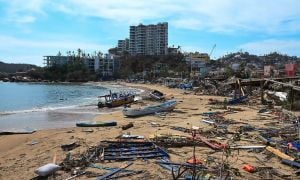A recent showdown between the New South Wales government and climate activists has led to significant developments. On Thursday, November 21, 2024, the NSW Supreme Court overturned attempts by the Minns government to restrict climate protests. This judicial ruling has reinvigorated the momentum of environmental campaigns leading up to significant planned protests slated for early December.
This latest decision came as hundreds of climate activists demonstrated their commitment to raising awareness about environmental issues. Activists from Rising Tide, a group committed to protecting biodiversity and addressing climate change, have been particularly vocal. They argue for greater action from the government on climate-related policies and have found innovative ways to make their message heard, including organizing protests near key shipping routes.
The court’s ruling nullified the government’s efforts to impose restrictions on protests, which activists deemed as excessive and unfounded. Premier Chris Minns expressed disappointment over the ruling but reaffirmed the government's stance on maintaining public safety and order during such activities. Supporters of environmental justice believe the win signifies not only the right to protest but also highlights the urgency of addressing climate change as Australia continues to contend with intense weather phenomena and ecological degradation.
This ruling symbolizes a moment of empowerment for the environmental movement, particularly among youth activists who have taken to the streets advocating for systematic change. Many young Australians feel compelled to act, driven by the fear of existential threats posed by climate change. They express frustration with both major political parties, which they accuse of failing to take meaningful action against climate threats.
Meanwhile, political reactions have been mixed. Some members of the Coalition have criticized the government's handling of the situation, arguing it reflects poorly on Minns' leadership. Shadow Minister for the Environment, Peter Dutton, emphasized the importance of prioritizing public interests and maintaining order, citing concerns about the potential disruptions protests could cause to everyday life.
On the ground, the recent protests have encompassed various forms of advocacy, including activism utilizing art installations to symbolize the destruction of natural resources. Activists employed creative methods ranging from large banners to artistic performances, all centered around calling for more stringent emissions regulations and dedicated renewable energy initiatives. These artistic displays have garnered significant public attention, increasingly engaging those who may not have previously considered the ramifications of climate change.
Adding another layer to this discourse, local Indigenous leaders have incorporated traditional knowledge and practices, positioning themselves en route as stewards of the land. This approach highlights the interconnectedness of Indigenous rights movements with environmental activism. Leaders from Aboriginal communities have been advocating for systemic change through initiatives focusing on land preservation and respect for nature, reinforcing cultural ties to the environment.
The upcoming protests scheduled for December are expected to draw thousands, as activist movements amplify their visibility through coordinated efforts across various cities. Social media platforms are expected to play instrumental roles, with organizers utilizing them to mobilize supporters swiftly, share information, and amplify their messages of sustainable living and restoration.
Ahead of the protests, many local communities are bracing for protests including sit-ins and roadblocks aimed at highlighting environmental injustices. This democratic expression of discontent is underscored by growing alarm over climate impacts on local communities, including rising sea levels threatening coastal residents and extreme weather events wreaking havoc across the state.
The response from state officials as the date approaches remains to be seen. Questions linger about how the NSW government might address public safety without dampening the enthusiasm of protestors advocating for urgent climate policies. The continuous legal back-and-forth sets the stage for heightened tension as climate activists prepare for what they're calling “the voice of the future.”
Observers suggest this chapter is reflective of broader global movements where young voices demand government accountability, pushing back against fossil fuel dependencies. The intersection of activism, politics, and community engagement is expected to evolve with increasing fervor as Australia grapples with its climate policies.
One can certainly say the outcome of these protests could sway political landscapes, influencing upcoming elections as the electorate weighs environmental stewardship with economic priorities. With this ruling, the stage is set for intensified engagements across Australia as climate advocacy remains at the forefront of public discourse.
While the future remains uncertain, one thing is clear: the movement is gathering steam, and its advocates refuse to remain silent until their calls for urgent climate action are heard. The protests scheduled for December will not only serve as platforms for activism but also as reminders of the growing urgency for collective action against the climate crisis.
Through this lens, the recent court ruling is more than just legal jargon. It’s emblematic of the shifting tides toward climate consciousness and action. With prominent activists and grassroots movements leading the charge, New South Wales is poised to enter choppy waters, prompting supporters to rally for environmental justice and igniting discussions about the future of sustainable development within the region. “This is just the beginning,” many activists declare, affirming their commitment to the long road ahead.
Regional governments, businesses, and local citizens alike will undoubtedly have to navigate the demands of climate activism intertwined with the realities of governance. The reality is this: climate activism is not just about policy; it's about people, their lives, and the values they choose to protect.



